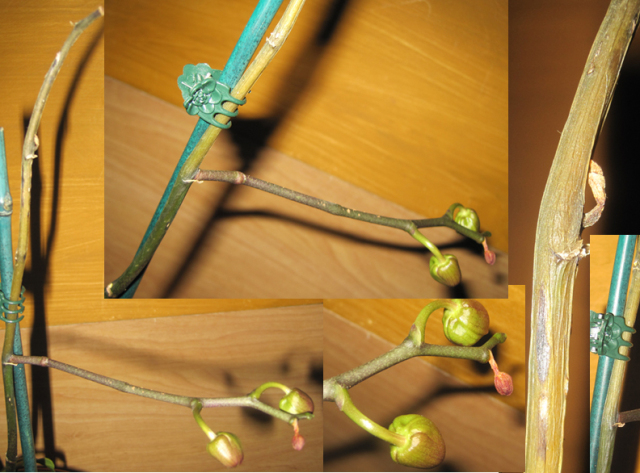Question Orchid stem dying
Orchid stem dying
QUESTION: Hi there, I've asked you a question regarding this very orchid about repotting it from sphagnum to a sphagnum fir bark mix and you've advised me to wait as it was in spike. Just to let you know, I did follow those instructions. However, I'm facing a quite shicking issue with it now, and am desperate for help!!! Up till about two days ago, my phal's progress looked great. Now, if you look at my pics (which I've attached with this question), you'll see that the original spike (from which the budded spike grew, and another one began a node above it but remained dormant) is dying at the top, it's already killed the dormant spike, but what will happen to the budded one??? Also as you can see, the third bud looks like it's lost its green cover MUCH too early, but the tip (where the new bud should emerge) still looks healthy... Can you give me an idea as to what may have caused this? I also noticed the last leaf was a little flimsy, so I detached it from the plant (the rest of the leaves look fairly healthy, but still not as firm as they used to be). What can I do to help my phal??? Oh, some details that may help are that I have the phal on a little humidity tray, I live in Toronto Canada, my phal is in a west-facing window (can it be too close since we've been getting great sun the past two days?), and I've been fertilizing with 19-31-17 orchid fertilizer (every other watering), I have NOT yet repotted the plant and got it just over a year ago... I REALLY want to save it, please help, thank you so much for all your time.
ANSWER: Sophia, the buds that are reddish will fall from the plant, which is normally part of the end of flowering. It is possible that the flower spike and its branches will turn brown and dry up as part of this process. The usual, normal process is for flower spike die back is from the tip of the spike or branch downward so I wouldn't be concerned about it. However, I would be concerned about some leaves are losing their turgor (ie not as firm) as this could be a sign ofimpending root rot and the need for repotting before it progresses too far. Even though there are some buds that could open, I think it more important to do the repotting now. As the flower spike dies back, you may cut off the dried portion just above a node and continue to do this as it continues to die back. Bottom line is that your plant is concluding its flowering cycle and that. per se, does not signal a problem.
When you repot, if the new potting mix seems dry, wet it prior to use (half hour soaking) as dry fir bark in the mix repels water and could draw water out of the roots. Soaking the potting mix prior to use will reduce the water repellancy. Be sure to remove any mushy roots prior to repotting and use a pot that has lots of drainage holes. An east facing window is generally preferred for phalaenopsis orchids as the west window can be quite bright compared to a window where the plant is exposed only to lower light levels of the morning sun.
---------- FOLLOW-UP ----------
QUESTION: Okay, so how long would it take for another flowering for my phal? Or, better yet, is this a good time to move it to a shady spot to try and induce a keiki? Of course, after the buds fully drop. Thanks, your time is well appreciated.
AnswerSophia, because repotting reqires the reestablishment of older root connections and the production of new roots, I recommend that you give your phal good light during the months following repotting. Most phals rebloom in the spring so, by repotting it now, you should have new bloom spikes in about a year. If you waant keikis by removing the plant to darkness for a week or more, you coud jeopardize the next flowering cycle. If the old flower spike remains green after re-establishment of the plant, the old flower spike could rebloom aand/or develop one or more keikis so I would just encourage you to concntrate on producing new roots and leaves. If, in the process, the plant's old bloom spike remains green and produces branches and/or keikis, that is fine and you can let nature take its course.






